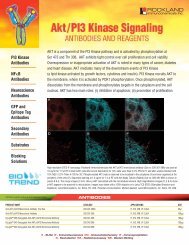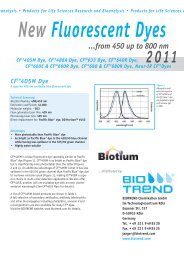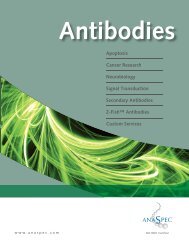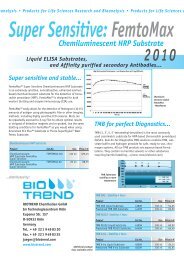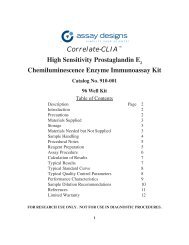Product Specification Sheet (PDF) - Biotrend
Product Specification Sheet (PDF) - Biotrend
Product Specification Sheet (PDF) - Biotrend
Create successful ePaper yourself
Turn your PDF publications into a flip-book with our unique Google optimized e-Paper software.
Human Leptin250 TubesCat. # HL-81K
HUMAN LEPTIN RIA KIT250 TUBES (Cat. # HL-81K)I. Intended Use 2II. Principles Of Procedure 2III. Reagents Supplied 3IV. Storage and Stability 4V. Reagent Precautions 4VI. Materials Required But Not Provided 5VII. Specimen Collection And Storage 5VIII. Assay Procedure 6IX. Calculations and Transformations 9X. Interpretation 10XI. Normal Fasting Range 10XII. Assay Characteristics 10XIII. Quality Controls 15XIV. Replacement Reagents 15XV. Ordering Information 16XVI. References 17
III.REAGENTS SUPPLIEDEach kit is sufficient to run 250 tubes and contains the following reagents.A. Assay Buffer0.05M Phosphosaline pH 7.4 containing 0.025M EDTA, 0.08% Sodium Azide, 1%RIA Grade BSA and 0.05% Triton X-100Quantity: 40 mL/vialPreparation: Ready to useB. Human Leptin AntibodyRabbit anti-Human Leptin Serum in Assay BufferQuantity: 26 mL/vialPreparation: Ready to useC.125 I-Human Leptin125 I-Human Leptin Label, HPLC purified (specific activity 135 µCi/µg)Lyophilized for stability. Freshly iodinated label contains
IV. STORAGE AND STABILITYUpon receipt, unused kit may be stored between 2 and 8°C for short term storage.For prolonged storage (>2 weeks), freeze unused kit at ≤ -20°C. Lyophilizedcomponents upon hydration should be stored at 5) freeze/thaw cycles. Refer to date on bottle forexpiration when stored at < - 20°C. Do not mix reagents from different kits unlessthey have the same lot number and are unopened.V. REAGENT PRECAUTIONSA. Radioactive MaterialsThis radioactive material may be received, acquired, possessed and used only byresearch personnel or clinical laboratories for in vitro research tests not involvinginternal or external administration of the material, or the radiation there from, tohuman beings or animals. Its receipt, acquisition, possession, use and transfer aresubject to the regulations of the U. S. Nuclear Regulatory Commission (NRC) or ofa State with which the Commission has entered into an agreement for the exerciseof regulatory authority.The following are suggested general rules for the safe use of radioactive material.The customer’s Radiation Safety Officer is ultimately responsible for the safehandling and use of radioactive material.1. Wear appropriate personal devices at all times while in areas where radioactivematerials are used or stored.2. Wear laboratory coats, disposable gloves, and other protective clothing at all times.3. Monitor hands, shoes, and clothing and immediate area surrounding the workstation for contamination after each procedure and before leaving the area.4. Do not eat, drink, or smoke in any area where radioactive materials are stored orused.5. Never pipette radioactive material by mouth.6. Dispose of radioactive waste in accordance with NRC rules and regulations.7. Avoid contaminating objects such as telephones, light switches, doorknobs, etc.8. Use absorbent pads for containing and easily disposing of small amounts ofcontamination.9. Wipe up all spills immediately and thoroughly and dispose of the contaminatedmaterials as radioactive waste. Inform Radiation Safety Officer.HL-81K-Rev 23-AUG-2011 4
V. REAGENT PRECAUTIONS (continued)B. Sodium AzideSodium Azide has been added to all reagents as a preservative at a concentrationof 0.08%. Although it is at a minimum concentration, Sodium Azide may react withlead and copper plumbing to form highly explosive metal azides. On disposal,flush with a large volume of water to prevent azide build up.VI. MATERIALS REQUIRED BUT NOT PROVIDED1. Borosilicate glass tubes, 12 x 75 mm. (NOTE: Polypropylene or polystyrene tubesmay be used if the investigator finds that the pellet formation is acceptably stable intheir system.)2. 100 µL pipet with disposable tips3. 100 µL & 1.0 mL repeating dispenser4. Refrigerated swing bucket centrifuge capable of developing 2,000 - 3,000xg. (Useof fixed-angle buckets is not recommended.)5. Absorbent paper6. Vortex mixer7. Refrigerator8. Gamma CounterVII. SPECIMEN COLLECTION AND STORAGE1. A maximum of 100 µL per assay tube of serum or plasma can be used, although,50 µL per assay tube is adequate for most applications. Tissue culture and othermedia may also be used.2. Care must be taken when using heparin as an anticoagulant, since an excess willprovide falsely high values. 4 Use no more than 10 IU heparin per mL of bloodcollected.3. Specimens can be stored at 4°C if they will be tested within 24 hours of collection.For longer storage, specimens should be stored at ≤ -20°C. Avoid multiple (>5)freeze/thaw cycles.4. Avoid using samples with gross hemolysis or lipemia.HL-81K-Rev 23-AUG-2011 5
VIII. ASSAY PROCEDUREStandard PreparationUse care in opening the Standard vial.Label seven glass tubes 1, 2, 3, 4, 5, 6 and 7. Add 1.0 mL Assay Buffer to each ofthe seven tubes. Prepare serial dilutions by adding 1.0 mL of the 100 ng/mLstandard to tube 1, mix well and transfer 1.0 mL of tube 1 to tube 2, mix well andtransfer 1.0 mL of tube 2 to tube 3, mix well and transfer 1.0 mL of tube 3 to tube4, mix well and transfer 1.0 mL of tube 4 to tube 5, mix well and transfer 1.0 mL oftube 5 to tube 6, mix well and transfer 1.0 mL of tube 6 to tube 7, mix well.Note: Do not use a Repeater pipette. Change tip for every dilution. Wet tip withStandard before dispensing. Unused portions of standard should be storedat ≤ -20°C. Avoid multiple freeze/thaw cycles.Tube #StandardConcentrationVolume ofAssay Buffer to AddVolume ofStandard to Add1 50 ng/mL 1.0 mL 1.0 mL of 100 ng/mL2 25 ng/mL 1.0 mL 1.0 mL of 50 ng/mL3 12.5 ng/mL 1.0 mL 1.0 mL of 25 ng/mL4 6.25 ng/mL 1.0 mL 1.0 mL of 12.5 ng/mL5 3.125 ng/mL 1.0 mL 1.0 mL of 6.25 ng/mL6 1.56 ng/mL 1.0 mL 1.0 mL of 3.125 ng/mL7 0.78 ng/mL 1.0 mL 1.0 mL of 1.56 ng/mLFor optimal results, accurate pipetting and adherence to the protocol are recommended.A. Assay Set-Up, Day One1. Pipet 300 µL of Assay Buffer to the Non-Specific Binding (NSB) tubes (3-4), 200µL to Reference (Bo) tubes (5-6), and 100 µL to tubes 7 through the end of theassay.2. Pipet 100 µL of Standards and Quality Controls in duplicate (see flow chart).3. Pipet 100 µL of each sample in duplicate.(NOTE: Smaller volumes of sample may be used when Leptin concentrations areanticipated to be elevated or when sample size is limited. Additional Assay Buffershould be added to compensate for the difference so that the volume is equivalentto 100 µL, e.g., when using 50 µL of sample, add 50 µL of Assay Buffer). Refer toSection IX for calculation modification.4. Pipet 100 µL of 125 I-Human Leptin to all tubes. Important: For preparation, seeSection III Part C.5. Pipet 100 µL of Human Leptin antibody to all tubes except Total Count tubes (1-2)and NSB tubes (3-4).6. Vortex, cover, and incubate overnight (20-24 hours) at 4°C.HL-81K-Rev 23-AUG-2011 6
B. Day Two7. Add 1.0 mL of cold (4°C) Precipitating Reagent to all tubes (except Total Counttubes).8. Vortex and incubate 20 minutes at 4°C.9. Centrifuge, 4°C, all tubes [except Total Count tubes (1-2)] for 20 minutes at 2,000-3,000xg. NOTE: If less than 2,000xg is used or if slipped pellets have beenobserved in previous runs, the time of centrifugation must be increased to obtain afirm pellet (e.g., 40 minutes). Multiple centrifuge runs within an assay must beconsistent.Conversion of rpm to xg:xg = (1.12 x 10 -5 ) (r) (rpm) 2r = radial distance in cm (from axis of rotation to the bottom of the tube)rpm = rotational velocity of the rotor10. Immediately decant the supernate of all tubes except Total Count tubes (1-2), draintubes for at least 15-60 seconds (be consistent between racks), and blot excessliquid from lip of tubes. NOTE: Invert tubes only one time. Pellets are fragile andslipping may occur.11. Count all tubes in a gamma counter for 1 minute. Calculate the ng/mL of HumanLeptin in unknown samples using automated data reduction procedures (seeSection IX).HL-81K-Rev 23-AUG-2011 7
Assay Flow ChartTube #Day OneStep 1 Step 2-3 Step 4 Step 5AddAssayBufferAddStandard / QC/SampleAdd125 I-LeptinTracerAddLeptinAntibodyStep6Day TwoStep 7 Step 8AddPrecipitatingReagent1,2 ---- ---- 100 µL ---- ----3,4 300 µL ---- 100 µL ---- 1.0 mL5,6 200 µL ---- 100 µL 100 µL 1.0 mL7,8 100 µL 100 µL of 0.78 ng/mL 100 µL 100 µL 1.0 mL9,10 100 µL 100 µL of 1.56 ng/mL 100 µL 100 µL 1.0 mL11,12 100 µL 100 µL of 3.125 ng/mL 100 µL 100 µL 1.0 mL13,14 100 µL 100 µL of 6.25 ng/mL 100 µL 100 µL 1.0 mL15,16 100 µL 100 µL of 12.5 ng/mL 100 µL 100 µL 1.0 mL17,18 100 µL 100 µL of 25 ng/mL 100 µL 100 µL 1.0 mL19,20 100 µL 100 µL of 50 ng/mL 100 µL 100 µL 1.0 mL21,22 100 µL 100 µL of 100 ng/mL 100 µL 100 µL 1.0 mL23,24 100 µL 100 µL of QC 1 100 µL 100 µL 1.0 mL25,26 100 µL 100 µL of QC 2 100 µL 100 µL 1.0 mL27,28 100 µL 100 µL of unknown 100 µL 100 µL 1.0 mL29-n 100 µL 100 µL of unknown 100 µL 100 µLVortex, Cover, and Incubate 20-24 hrs at 4°C1.0 mLVortex, and Incubate 20 min. at 4°CStep9-11Centrifuge for 20 min.,Decant, and Count pelletsHL-81K-Rev 23-AUG-2011 8
IX. CALCULATIONS AND TRANSFORMATIONSA. ExplanationThe calculations for Human Leptin can be automatically performed by mostgamma counters possessing data reduction capabilities or by independenttreatment of the raw data using a commercially available software package 5 .Choose weighted 4-parameter or weighted log/logit for the mathematical treatmentof the data.NOTE: Be certain the procedure used subtracts the NSB counts from eachaverage count, except Total Counts, prior to final data reduction.B. Manual Calculation1. Average duplicate counts for Total Count tubes (1-2), NSB tubes (3-4), TotalBinding tubes (reference, Bo) (5-6), and all duplicate tubes for standards andsamples to the end of the assay.2. Subtract the average NSB counts from each average count (except for TotalCounts). These counts are used in the following calculations.3. Calculate the percentage of tracer bound(Total Binding Counts/Total Counts) X 100This should be 35-50%.4. Calculate the percentage of total binding (%B/Bo) for each standard and sample%B/Bo = (Sample or Standard/Total Binding) X 1005. Plot the % B/Bo for each standard on the y-axis and the known concentration ofthe standard on the x-axis using log-log graph paper.6. Construct the reference curve by joining the points with a smooth curve.7. Determine the ng/mL of Human Leptin in the unknown samples and controls byinterpolation of the reference curve.NOTE: When sample volumes assayed differ from 100 µL, an appropriatemathematical adjustment must be made to accommodate for the dilutionfactor (e.g., if 50 µL of sample is used, then calculated data must bemultiplied by 2).HL-81K-Rev 23-AUG-2011 9
X. INTERPRETATIONA. Acceptance Criteria1. The run will be considered accepted when all Quality Control values fall within thecalculated Quality Control Range; if any QC’s fall outside the control range, reviewresults with supervisor.2. If the difference between duplicate results of a sample is >10% CV, repeat thesample.3. The limit of sensitivity for the Human Leptin assay is 0.437 ng/mL + 2 SD (100 µLsample size).4. The limit of linearity for the Human Leptin assay is 100 ng/mL (100 µL samplesize). Any result greater than 100 ng/mL should be repeated on dilution usingAssay Buffer as a diluent.XI. NORMAL FASTING RANGE 3Leptin levels are directly correlated with degree of adiposity.Mean Leptin Values (BMI ranges 18-25):Lean Men 3.8 ± 1.8 µg/LLean Women 7.4 ± 3.7 µg/LLevels rise approximately 2.5 times faster in women per unit BMI as compared tomen. 3XII. ASSAY CHARACTERISTICSA. SensitivityThe lowest level of Leptin that can be detected by this assay is 0.437 ng/mL + 2SD when using a 100 µL sample size.B. PerformanceThe following parameters of assay performance are expressed as Mean ±Standard Deviation.ED 80 = 1.5 ng/mL ± 0.25 ng/mLED 50 = 7.1 ng/mL ± 0.76 ng/mLED 20 = 36.4 ng/mL ± 2.19 ng/mLHL-81K-Rev 23-AUG-2011 10
XII. ASSAY CHARACTERISTICS (continued)C. SpecificityThe specificity (also known as selectivity) of an analytical test is its ability toselectively measure the analyte in the presence of other like components in thesample matrix.Human Leptin 100%Rat Leptin
XII. ASSAY CHARACTERISTICS (continued)E. RecoverySpike & Recovery of Leptin in Human SerumSampleNo.LeptinAddedng/mLObservedng/mLExpectedng/mL% Recovery1 0 4.9 - -2 2 7.2 6.9 1043 5 10.4 9.9 1054 10 15.7 14.9 1055 20 25.6 24.9 103Varying concentrations of Human Leptin were added to five human serum samplesand the Leptin content was determined by RIA. Mean of the observed levels fromfive duplicate determinations in five separate assays are shown. Percent recoverywas calculated on the observed vs. expected.HL-81K-Rev 23-AUG-2011 12
F. LinearityEffect of Serum DilutionSample Volume Observed Expected % OfNo. Sampled ng/mL ng/mL Expected1 100 µL 45.7 45.7 10075 µL 45.3 9950 µL 45.6 10025 µL 46.1 1012 100 µL 31.2 31.2 10075 µL 31.2 10050 µL 31.3 10025 µL 31.0 993 100 µL 13.8 13.8 10075 µL 13.1 9550 µL 12.5 9125 µL 12.1 884 100 µL 9.1 9.1 10075 µL 8.6 9550 µL 8.7 9625 µL 8.4 92Aliquots of pooled human serum containing varying concentrations of Leptin wereanalyzed in the volumes indicated. Dilution factors of 1, 1.33, 2 and 4 representing100 µL, 75 µL, 50 µL and 25 µL, respectively, were applied in calculating observedconcentrations. Mean Leptin levels and percent of expected for five separate assaysare shown.HL-81K-Rev 23-AUG-2011 13
XII. ASSAY CHARACTERISTICS (continued)G. Example of Assay ResultsThis data is presented as an example only and should not be used in lieu of astandard curve prepared with each assay.Tube#ID CPM Ave CPMAve NetCPM % B/Bo ng/mL1 Totals 15857 160602 162623 NSB 745 7234 7015 Bo 7614 7629 69066 7643Standards7 0.78 ng/mL 7062 7155 6432 0.9318 72489 1.56 ng/mL 6383 6428 5705 0.82610 647311 3.125 ng/mL 5459 5487 4764 0.69012 551513 6.25 ng/mL 4530 4515 3792 0.54914 450015 12.5 ng/mL 3354 3354 2631 0.38116 335417 25 ng/mL 2373 2449 1726 0.25018 252519 50 ng/mL 2008 1983 1260 0.18220 195821 100 ng/mL 1592 1585 862 0.1251578Controls/Unknown23 QC 1 5053 5079 4356 0.631 4.1424 510525 QC 2 2978 2910 2187 0.317 17.1226 284227-n UnknownHL-81K-Rev 23-AUG-2011 14
XIII. QUALITY CONTROLSGood Laboratory Practice requires that Quality Control specimens be run with eachstandard curve to check the assay performance. Two levels of controls are provided forthis purpose. These and any other control materials should be assayed repeatedly toestablish mean values and acceptable ranges. Each individual laboratory is responsiblefor defining their system for quality control decisions and is also responsible for makingthis system a written part of their laboratory manual. The ranges for Quality Control 1and 2 are provided on the card insert or can be located at the <strong>Biotrend</strong> website www.biotrend.comRecommended batch analysis decision using two controls (Westgard Rule) 6 :1. When both controls are within ±2 SD. Decision: Approve batch and releaseanalyte results.2. When one control is outside ±2 SD and the second control is within ±2 SD.Decision: Hold results, check with supervisor. If no obvious source of error isidentified by the below mentioned check of systems, the supervisor may decide torelease the results.Technician check of systems:1. Check for calculation errors2. Repeat standards and controls3. Check reagent solutions4. Check instrumentXIV. REPLACEMENT REAGENTSReagents Cat #125 I-Human Leptin (
XV. ORDERING INFORMATIONA. To place an order:For USA Customers:Please provide the following information to our customer service department toexpedite your telephone, fax or mail order:1. Your name, telephone and/or fax number2. Customer account number3. Shipping and billing address4. Purchase order number5. Catalog number and description of product6. Quantity and product sizeNOTE: Appropriate license from NRC (or equivalent) must be on file at <strong>Biotrend</strong>before radioactive orders can be shipped.B. Conditions of SaleAll products are for research or manufacturing use only. They are not intended foruse in clinical diagnosis or for administration to humans or animals. All productsare intended for in vitro use only.C. Material Safety Data <strong>Sheet</strong>s (MSDS)Material safety data sheets for <strong>Biotrend</strong> products may be ordered by fax or phone.See Section A above for details on ordering.HL-81K-Rev 23-AUG-2011 16
XVI. REFERENCES1. Pelleymounter, M.A., et. al. Effects of the obese gene product on body weightregulation in ob/ob mice. Science. 269:540-543, 1995.2. Maffei, M., et. al. Leptin levels in human and rodent: measurement of plasmaleptin an ob RNA in obese and weight-reduced subjects. Nature Med. Vol. 1,11:1155-1611, 1995.3. Ma, Zhongmin, et al. Radioimmunoassay of leptin in human plasma. ClinicalChemistry. 42:942-946, June, 1996.4. Thorell, J.I. Scand. J. Clin. Lab. Invest. 31:187, 1973.5. Feldman, H. and Rodbard, D. “Mathematical Theory of Radioimmunoassay”,in:W.D Odell and Doughaday, W.H. (Ed.), Principles of Competitive Protein-Binding Assays. Philadelphia: J.B. Leppincott Company; pp 158-203, 1971.6. Westgard, J.O., et. al. A multi-rule Shewhart chart for quality control in clinicalchemistry. Clin. Chem. 27:493-501, 1981.HL-81K-Rev 23-AUG-2011 17



